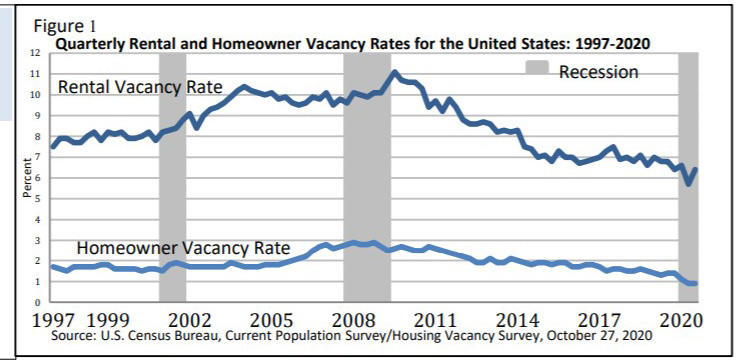
3Q Homeownership Rate Falls by 0.5%

(Chart: U.S. Census Bureau.)
Despite a jump in home purchase activity this summer—but also perhaps because of the coronavirus pandemic—the U.S. homeownership rate slipped by 0.5 percent in the third quarter, the Census Bureau reported Thursday.
The report said the homeownership rate fell to 67.4 percent in the third quarter, down from 67.9 percent in the second quarter but up from 64.8 percent a year ago. Regionally, the Midwest had the highest homeownership rate (71.2 percent), followed by the South (70.8 percent) the West (62.1 percent) and the Northeast (62 percent).
Racial disparities continued to persist in the third quarter. White households (non-Hispanic) had the highest homeownership rate at 75.8 percent, followed by Asian-American households (61 percent). African American households had the lowest homeownership rate (46.4 percent).
Households aged 65 years and over had the highest homeownership rate (80.7 percent); households under 35 had the lowest rate (40.2 percent).
Other key data:
–National vacancy rates in the third quarter were 6.4 percent for rental housing and 0.9 percent for homeowner housing. The rental vacancy rate of 6.4 percent was 0.4 percentage points lower than a year ago (6.8 percent) but 0.7 percentage points higher than the rate in the second quarter (5.7 percent). The homeowner vacancy rate of 0.9 percent was 0.5 percentage points lower than the rate a year ago (1.4 percent) and virtually unchanged from the second quarter (0.9 percent).
–89.9 percent of the housing units in the United States in the third quarter were occupied and 10.1 percent were vacant. Owner-occupied housing units made up 60.6 percent of total housing units, while renter-occupied units made up 29.3 percent of the inventory in the third quarter 2020. Vacant year-round units comprised 7.6 percent of total housing units, while 2.5 percent were vacant for seasonal use.
–Two percent of the total units were vacant for rent, 0.6 percent were vacant for sale only and 0.7 percent were rented or sold but not yet occupied. Vacant units that were held off market comprised 4.3 percent of the total housing stock – 1.3 percent were for occasional use, 0.7 percent were temporarily occupied by persons with usual residence elsewhere and 2.3 percent were vacant for a variety of other reasons.
